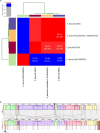Probiotic Potential and Safety Evaluation of Enterococcus faecalis OB14 and OB15, Isolated From Traditional Tunisian Testouri Cheese and Rigouta, Using Physiological and Genomic Analysis
- PMID: 31105672
- PMCID: PMC6491886
- DOI: 10.3389/fmicb.2019.00881
Probiotic Potential and Safety Evaluation of Enterococcus faecalis OB14 and OB15, Isolated From Traditional Tunisian Testouri Cheese and Rigouta, Using Physiological and Genomic Analysis
Abstract
Lactic acid bacteria (LAB) strains OB14 and OB15 were isolated from traditional Tunisian fermented dairy products, Testouri cheese and Rigouta, respectively. They were identified as Enterococcus faecalis by the MALDI TOF-MS (matrix assisted laser desorption-ionization time of flight mass spectrometry) biotyper system and molecular assays (species-specific PCR). These new isolates were evaluated for probiotic properties, compared to E. faecalis Symbioflor 1 clone DSM 16431, as reference. The bacteria were found to be tolerant to the harsh conditions of the gastrointestinal tract (acidity and bile salt). They were low to moderate biofilm producers, can adhere to Caco-2/TC7 intestinal cells and strengthen the intestinal barrier through the increase of the transepithelial electrical resistance (TER). Susceptibility to ampicillin, vancomycin, gentamicin and erythromycin has been tested using the broth microdilutions method. The results demonstrated that E. faecalis OB14 and OB15 were sensitive to the clinically important ampicillin (MIC = 1 μg/mL) and vancomycin (MIC = 2 μg/mL) antibiotics. However, Whole Genome Sequencing (WGS) showed the presence of tetracycline resistance and cytolysin genes in E. faecalis OB14, and this led to high mortality of Galleria Mellonella larvae in the virulence test. Hierarchical cluster analysis by MALDI TOF-MS biotyper showed that E. faecalis OB15 was closely related to the E. faecalis Symbioflor 1 probiotic strain than to OB14, and this has been confirmed by WGS using the average nucleotide identity (ANI) and Genome-to-Genome Hybridization similarity methods. According to these results, E. faecalis OB15 seems to be reliable for future development as probiotic, in food or feed industry.
Keywords: Enterococcus faecalis; Rigouta; Testouri cheese; antibiotic resistance; genomic analysis; probiotics; safety; virulence.
Figures







Similar articles
-
Influence of Catecholamines (Epinephrine/Norepinephrine) on Biofilm Formation and Adhesion in Pathogenic and Probiotic Strains of Enterococcus faecalis.Front Microbiol. 2020 Jul 24;11:1501. doi: 10.3389/fmicb.2020.01501. eCollection 2020. Front Microbiol. 2020. PMID: 32849320 Free PMC article.
-
Draft Genome Sequence of Enterococcus faecalis Strain OB15, a Probiotic Strain Recently Isolated from Tunisian Rigouta Cheese.Microbiol Resour Announc. 2020 Apr 9;9(15):e01433-19. doi: 10.1128/MRA.01433-19. Microbiol Resour Announc. 2020. PMID: 32273368 Free PMC article.
-
Prevalence and characterization of Enterococcus spp. isolated from Brazilian foods.Food Microbiol. 2008 Aug;25(5):668-75. doi: 10.1016/j.fm.2008.03.008. Epub 2008 Apr 7. Food Microbiol. 2008. PMID: 18541165
-
High-Level Antibiotic Tolerance of a Clinically Isolated Enterococcus faecalis Strain.Appl Environ Microbiol. 2020 Dec 17;87(1):e02083-20. doi: 10.1128/AEM.02083-20. Print 2020 Dec 17. Appl Environ Microbiol. 2020. PMID: 33097497 Free PMC article.
-
Enterococcus spp. in Ragusano PDO and Pecorino Siciliano cheese types: A snapshot of their antibiotic resistance distribution.Food Chem Toxicol. 2018 Oct;120:277-286. doi: 10.1016/j.fct.2018.07.023. Epub 2018 Jul 20. Food Chem Toxicol. 2018. PMID: 30009890
Cited by
-
Mobile Antimicrobial Resistance Genes in Probiotics.Antibiotics (Basel). 2021 Oct 21;10(11):1287. doi: 10.3390/antibiotics10111287. Antibiotics (Basel). 2021. PMID: 34827225 Free PMC article.
-
Evaluation of the probiotic, technological, safety attributes, and GABA-producing capacity of microorganisms isolated from Iranian milk kefir beverages.Front Microbiol. 2024 Jun 5;15:1385301. doi: 10.3389/fmicb.2024.1385301. eCollection 2024. Front Microbiol. 2024. PMID: 38903778 Free PMC article.
-
Genomic evaluation of the probiotic and pathogenic features of Enterococcus faecalis from human breast milk and comparison with the isolates from animal milk and clinical specimens.PeerJ. 2024 Oct 29;12:e18392. doi: 10.7717/peerj.18392. eCollection 2024. PeerJ. 2024. PMID: 39494274 Free PMC article.
-
Enterococci from Raw-Milk Cheeses: Current Knowledge on Safety, Technological, and Probiotic Concerns.Foods. 2021 Nov 10;10(11):2753. doi: 10.3390/foods10112753. Foods. 2021. PMID: 34829034 Free PMC article. Review.
-
Compatibility, Cytotoxicity, and Gastrointestinal Tenacity of Bacteriocin-Producing Bacteria Selected for a Consortium Probiotic Formulation to Be Used in Livestock Feed.Probiotics Antimicrob Proteins. 2021 Feb;13(1):208-217. doi: 10.1007/s12602-020-09687-y. Probiotics Antimicrob Proteins. 2021. PMID: 32712896
References
-
- Anandharaj M., Sivasankari B., Santhanakaruppu R., Manimaran M., Rani R. P., Sivakumar S. (2015). Determining the probiotic potential of cholesterol-reducing Lactobacillus and Weissella strains isolated from gherkins (fermented cucumber) and south Indian fermented koozh. Res. Microbiol. 166 428–439. 10.1016/j.resmic.2015.03.002 - DOI - PubMed
LinkOut - more resources
Full Text Sources
Miscellaneous

